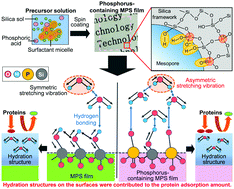Control of the hydration layer states on phosphorus-containing mesoporous silica films and their reactivity evaluation with biological fluids†
Abstract
Transparent phosphorus-containing MPS (PMPS) films were synthesized by the introduction and reaction of phosphoric acid into the silica framework during the sol–gel reaction. We then investigated the hydration layer structures formed on the PMPS films and achieved the selective adsorption of fibronectin (Fn). In particular, the surface analyses indicated that the P atom was distributed at the outermost surfaces of the PMPS films. The PMPS films exhibited a high transparency (e.g., averaged transmittance value in the visible light region: 79%), and the haze value (0.14%) decreased with the increasing P/Si molar concentration. Solid-state 29Si-NMR and Fourier transform infrared spectroscopy (FT-IR) spectra indicated the formation of Si–O–P bonds, suggesting that the condensation reaction between the Si–O− and P–O− groups effectively occurs in the silica framework. The larger amount of P–O− and P![[double bond, length as m-dash]](https://www.rsc.org/images/entities/char_e001.gif) O groups at the Si–O–P bonding site on the films affects the water molecular adsorption states (i.e., formation of the hydration layer), which was supported by the Brunauer–Emmett–Teller (BET) surface areas of N2 and water vapor, leading to enhancement of the hydrogen bondability of the PMPS films with the increased formation of Si–O–P bonds. The deconvolution results of the FT-IR spectra demonstrated that the ratio of free water to bonding water increased significantly with an increase in the formation of Si–O–P bonding, and the resulting O–H stretching vibration in the hydration layer became more asymmetric. It is suggested that the water molecules are irregularly hydrogen-bonded with the different functional groups of Si–O−, P–O− and P
O groups at the Si–O–P bonding site on the films affects the water molecular adsorption states (i.e., formation of the hydration layer), which was supported by the Brunauer–Emmett–Teller (BET) surface areas of N2 and water vapor, leading to enhancement of the hydrogen bondability of the PMPS films with the increased formation of Si–O–P bonds. The deconvolution results of the FT-IR spectra demonstrated that the ratio of free water to bonding water increased significantly with an increase in the formation of Si–O–P bonding, and the resulting O–H stretching vibration in the hydration layer became more asymmetric. It is suggested that the water molecules are irregularly hydrogen-bonded with the different functional groups of Si–O−, P–O− and P![[double bond, length as m-dash]](https://www.rsc.org/images/entities/char_e001.gif) O. In the immersion experiment of the PMPS films in phosphate buffer, the resultant P/Si molar concentration of the PMPS film decreased upon increasing the immersion time and the mesostructures were preserved. The amount of Fn adsorption significantly increased as the O–H stretching vibration of the water molecules became more asymmetric, whereas the adsorption of fibrinogen was completely suppressed by the films. Therefore, we found that the addition of phosphoric acid in the MPS film synthesis significantly affects the hydration layer structures on the film surfaces to provide the possibility of selective protein adsorption.
O. In the immersion experiment of the PMPS films in phosphate buffer, the resultant P/Si molar concentration of the PMPS film decreased upon increasing the immersion time and the mesostructures were preserved. The amount of Fn adsorption significantly increased as the O–H stretching vibration of the water molecules became more asymmetric, whereas the adsorption of fibrinogen was completely suppressed by the films. Therefore, we found that the addition of phosphoric acid in the MPS film synthesis significantly affects the hydration layer structures on the film surfaces to provide the possibility of selective protein adsorption.



 Please wait while we load your content...
Please wait while we load your content...